Sentosa, Singapore – Monday, March 7th, 2011
 One thing that sets Universal Studios Singapore apart is how demographically split the park is. The front half of the park (Hollywood, New York City, Madagascar, and Far Far Away) is heavily geared towards kids and families, while the back half (The Lost World, Ancient Egypt, Sci-Fi City) is where all the high-thrill rides are found. The merits of such a plan are debatable, since it tends to reduce circulation as guests stick only to the areas that are more comfortable or interesting to them. (As a personal example, I really only traipsed through Madagascar and Far Far Away once during my entire day-long visit.) But on the other hand, when queues are short it makes it easy to finish the day by going back and forth to marathon Mummy and Battlestar Galactica: CYLON repeatedly, which isn’t a bad trade-off.
One thing that sets Universal Studios Singapore apart is how demographically split the park is. The front half of the park (Hollywood, New York City, Madagascar, and Far Far Away) is heavily geared towards kids and families, while the back half (The Lost World, Ancient Egypt, Sci-Fi City) is where all the high-thrill rides are found. The merits of such a plan are debatable, since it tends to reduce circulation as guests stick only to the areas that are more comfortable or interesting to them. (As a personal example, I really only traipsed through Madagascar and Far Far Away once during my entire day-long visit.) But on the other hand, when queues are short it makes it easy to finish the day by going back and forth to marathon Mummy and Battlestar Galactica: CYLON repeatedly, which isn’t a bad trade-off.
This part of the tour begins in The Lost World, which is actually divided into two sections: the main Jurassic Park area, and the Waterworld stunt show, because they couldn’t fit it anywhere else apparently.
The Lost World was built at an awkward time for the Jurassic franchise. The last Jurassic Park film was already nearly a decade old at the time of opening and even that film didn’t exactly provide the brand with a lot of quality content. Yet waiting a few more years for Jurassic World to reboot the franchise obviously wasn’t a possibility for a landlocked park with no room to set aside for a land-scale expansion pad. So instead we’re stuck with a new-ish interpretation of an old-ish story, and that combination doesn’t do the park nor the films any favors.

 One challenge with building Jurassic Park in a theme park context is that theming is already part of the brand vocabulary, so it’s not always clear when a themed element is supposed to be “real” versus “themed”. Previous examples seemed to set a pretty clear boundary (dinosaurs are only seen on the rides and always “real”, and the public areas stick to a fossil and tropical visitor center aesthetic), but this distinction becomes much more blurred in the Singapore version, possibly because the dinos are less prominent on the featured rapids ride.
One challenge with building Jurassic Park in a theme park context is that theming is already part of the brand vocabulary, so it’s not always clear when a themed element is supposed to be “real” versus “themed”. Previous examples seemed to set a pretty clear boundary (dinosaurs are only seen on the rides and always “real”, and the public areas stick to a fossil and tropical visitor center aesthetic), but this distinction becomes much more blurred in the Singapore version, possibly because the dinos are less prominent on the featured rapids ride.




 The Jurassic Park Rapids Adventure is Singapore’s unique take on the successful Jurassic Park: The Ride / River Adventure found at the other three Universal locations (and still my vote for the best attraction Universal has ever created).
The Jurassic Park Rapids Adventure is Singapore’s unique take on the successful Jurassic Park: The Ride / River Adventure found at the other three Universal locations (and still my vote for the best attraction Universal has ever created).
Instead of a large, slow-moving raft ride with a large splashdown finale, the Singapore version utilizes smaller round rafts with a wetter white water course and a smaller finale drop.
While I’m sure the decision to change ride systems made sense on paper, it unfortunately results in a far inferior guest experience. Because you’re facing inward and spinning, it’s nearly impossible to draw focus out onto the few dinosaurs that do appear along the route.
It also levels out the pacing of the ride; there’s no “rising action” or climax, because the adventure becomes more about encountering the rapids than the dinosaurs.
There is still a halfway decent finale, with an elevator lift that threatens to feed you into the mouth of a hungry T-rex before spilling out into a small waterfall on the other side. The staging of this sequence was pretty effective, if not a little undersized. But it was also too little, too late, not well integrated with any story. A splashdown using a round raft also has the tendency to flood the boat, resulting in wet shoes and socks for the rest of the day that refused to dry out in Singapore’s humidity. A lighter refreshing spray would have been much more enjoyable.
The area’s second main attraction is the Canopy Flyer, an enlarged version of the Pteranodon Flyers at Islands of Adventure created by Setpoint. The station has a ridiculously huge footprint for what’s essentially a low-level attraction.
Unlike Pteranodon Flyer, Canopy Flyer is given a more generic jungle and dinosaur theme. It’s a vastly superior ride for the sole virtue of the fact that guests are actually allowed to ride it.
While the four person seating has much better capacity than the Florida counterpart, it’s still the slowest moving queue in the park and was the only attraction that built up a sizable wait in the afternoon during my visit. Given that it doesn’t serve a clear story purpose for the land and experientially isn’t much different than the other family coasters at the park (especially with the new suspended Puss In Boots coaster added since my visit), I wouldn’t be surprised if this one gets cut in the not-too-distant future.

 Speaking of dinosaurs… Waterworld: A Live Sea War Spectacular has somehow found its way into this park despite being based on a box office flop fifteen years old at the time the park opened, oddly leaving Orlando as the only Universal resort without the show.
Speaking of dinosaurs… Waterworld: A Live Sea War Spectacular has somehow found its way into this park despite being based on a box office flop fifteen years old at the time the park opened, oddly leaving Orlando as the only Universal resort without the show.
People just really love this show.
And for good reason; it’s still a very dynamic show that works well within a theme park setting and translates among an international audience. With so many Universal shows failing to find an audience, it’s not surprising that their one indisputable hit has been carried on for as long as it has.
Beginning to turn back around the loop towards the front of the park is Ancient Egypt.
Along with New York City, this was possibly my favorite land in the park from a purely environmental point-of-view. Although its marquee attraction is technically based on the 1999 film The Mummy, they wisely decided to strip the land of anything too brand-specific and make it a more generic, aspirational version of Egypt that should resonate with audiences regardless of who’s the latest star in Universal’s long-running Mummy franchise.
Surprisingly large-scale monumental design elements all leave a very strong impression upon first arrival. I wish like New York City or Far Far Away there could have been a little more detail and discovery, but the use of scale and texture plays to many of the strengths of more traditional themed design that’s refreshing to see in a modern 21st century park.


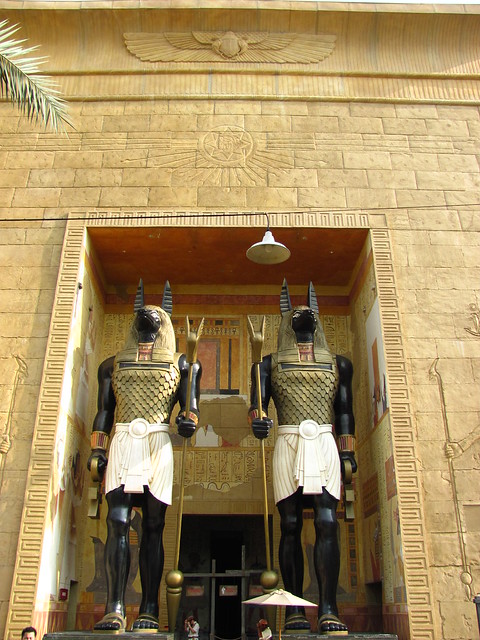 That absolutely massive facade is the entrance to Revenge of the Mummy, the third and best iteration of the indoor roller coaster that first debuted at the two American Universal Studios in 2004.
That absolutely massive facade is the entrance to Revenge of the Mummy, the third and best iteration of the indoor roller coaster that first debuted at the two American Universal Studios in 2004.
Most of that strength comes from a superior queue and story set-up. This is the one version of the ride that actually allows it to live fully in Egypt, and not on a Hollywood soundstage or a New York museum of antiquities. (That also means no confusing Brendan Fraser cameos.)
As one of the park’s highest capacity thrill rides, I’m almost disappointed there wasn’t a longer wait that allowed for more time to take in the queue atmosphere (or take advantage of the single rider queue, which would have been much more welcome on low-capacity rides like the Canopy Flyer).
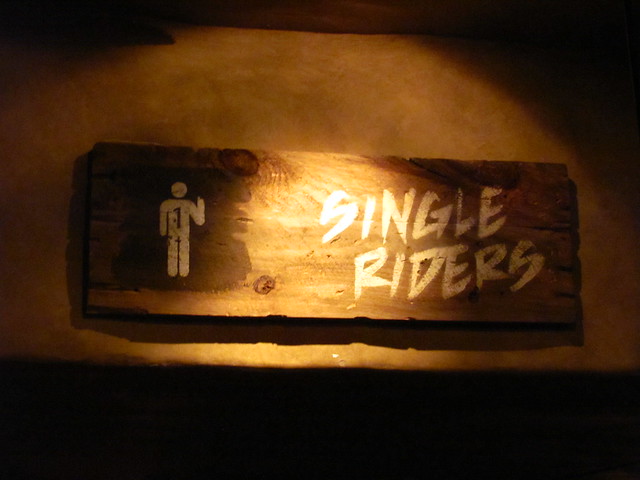 Minus some show changes to remove all the meta-textual references to the movies or being on a theme park attraction, the ride itself is more or less identical to the Florida version of Mummy. While I actually believe the Hollywood version is underrated and find the Florida version a bit overrated, Singapore finds the happy medium between the two.
Minus some show changes to remove all the meta-textual references to the movies or being on a theme park attraction, the ride itself is more or less identical to the Florida version of Mummy. While I actually believe the Hollywood version is underrated and find the Florida version a bit overrated, Singapore finds the happy medium between the two.
Ancient Egypt has a secondary attraction in the form of Treasure Hunters, an antique car ride through Egyptian ruins that almost acts as a sort of outdoor dark ride. Given the lack of opening-day dark rides at this park, this was a simple yet appreciated attraction.


 It’s a little bit like if Autopia, Indiana Jones Adventure, and the Jungle Cruise all produced an attraction off-spring. Lots of animals along the layout, though most with limited or no motion.
It’s a little bit like if Autopia, Indiana Jones Adventure, and the Jungle Cruise all produced an attraction off-spring. Lots of animals along the layout, though most with limited or no motion.
These scarab beetle scenes featured a few of the only moving show pieces along the layout. More than a little cheesy, especially when they’re all in bright blues, but it shows more effort than nearly any other car ride I can think of.
The other benefit of Treasure Hunters is the way it’s able to activate the rest of Ancient Egypt and enrich the thematic environment for spectators, rather than simply be cordoned away in a show box.
Moving on to the final land…
 Sci Fi City is Universal Studios Singapore’s answer for Tomorrowland.
Sci Fi City is Universal Studios Singapore’s answer for Tomorrowland.
Sci Fi City is divided into two parts; the main covered boulevard, and then an outdoor section that’s primarily dominated by Battlestar Galactica. While Ancient Egypt is able to use familiar tropes to convey its story with a light touch, Sci Fi City has to invent its own design language which results in a space that feels confusingly generic. Even the name of the land sounds like a temporary placeholder that never got updated. There’s a lot of cyberpunk design that’s suggestive of something more specific, but then there’s no actual story behind any of it, instead being used as a blank slate upon which otherwise unrelated IP-based stories like Transformers and Battlestar Galactica could be cast. It perhaps doesn’t help that it feels like the smallest area of the park in terms of total footpath area.
Transformers: The Ride was already announced but not yet opened at the time of my visit. I’m not certain, but I believe this is the facade where the entrance would later be placed.
 Accelerator is Sci Fi City’s second opening day attraction along with the coasters. A non-IP copy of Storm Force Accelatron at Islands of Adventure, this is basically an oversized teacup attraction that had all the fun engineered out of it. The whole point of a teacup ride is being able to whip around the cars in circles until you’re too dizzy to take it anymore, but with these lumbering, oversized cars there’s too much resistance and inertia to do anything fun with them. (Also, being the only person on the ride was less fun than it sounds.) Oh well.
Accelerator is Sci Fi City’s second opening day attraction along with the coasters. A non-IP copy of Storm Force Accelatron at Islands of Adventure, this is basically an oversized teacup attraction that had all the fun engineered out of it. The whole point of a teacup ride is being able to whip around the cars in circles until you’re too dizzy to take it anymore, but with these lumbering, oversized cars there’s too much resistance and inertia to do anything fun with them. (Also, being the only person on the ride was less fun than it sounds.) Oh well.

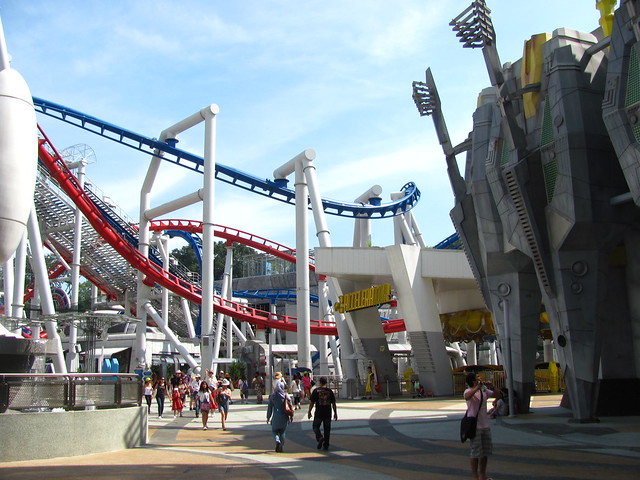 Sci Fi City as a whole might be a bit light on context, although a small waterfall feature at the lagoon’s edge sure has an impressive fictionalized resume that someone in Universal Creative wanted the world to know about.
Sci Fi City as a whole might be a bit light on context, although a small waterfall feature at the lagoon’s edge sure has an impressive fictionalized resume that someone in Universal Creative wanted the world to know about.
Finally, the big one: Battlestar Galactica, Universal Studios Singapore’s largest unique attraction, a dueling family sit-down / inverted looping coaster built by Vekoma.
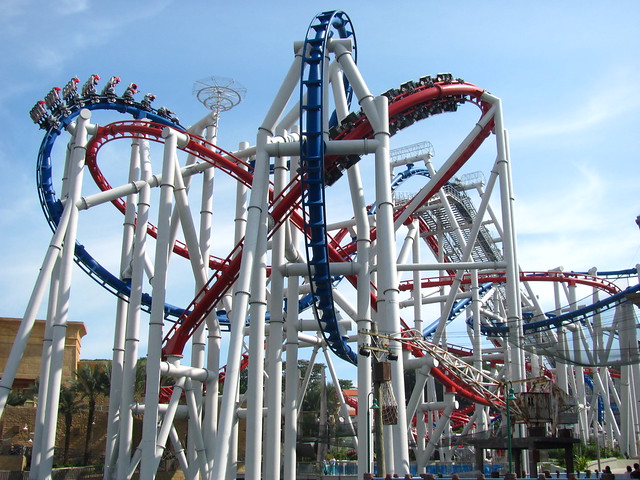
 Battlestar Galactica was one of the first major installations using the new Vekoma track and train configuration which was supposed to announce them as a serious player in the coaster design world alongside established heavyweights like B&M and Intamin. Unfortunately the opening year didn’t go as smoothly as planned; shortly after opening, during a test run, a seat broke off and landed in the midway. No one was hurt, but that didn’t exactly bode well for the engineering quality of the new multi-million dollar attraction. After eleven months of re-engineering they were finally able to reopen the coaster just a few weeks before my visit. Not all the kinks were resolved as it spent the first couple hours of the day closed, but by afternoon they had it running and I was able to ride both sides multiple times throughout the day. The ride sat closed again from 2013 to 2015 to reduce the trains to seat only two abrest, so I was lucky to experience it during its first relatively brief window of operation.
Battlestar Galactica was one of the first major installations using the new Vekoma track and train configuration which was supposed to announce them as a serious player in the coaster design world alongside established heavyweights like B&M and Intamin. Unfortunately the opening year didn’t go as smoothly as planned; shortly after opening, during a test run, a seat broke off and landed in the midway. No one was hurt, but that didn’t exactly bode well for the engineering quality of the new multi-million dollar attraction. After eleven months of re-engineering they were finally able to reopen the coaster just a few weeks before my visit. Not all the kinks were resolved as it spent the first couple hours of the day closed, but by afternoon they had it running and I was able to ride both sides multiple times throughout the day. The ride sat closed again from 2013 to 2015 to reduce the trains to seat only two abrest, so I was lucky to experience it during its first relatively brief window of operation.
 First up, the red sit-down “Human” side.
First up, the red sit-down “Human” side.
Battlestar Galactica is a somewhat unconventional choice of IP for a major marquee attraction, although I suppose Universal has selected stranger IP for their parks before (an entire land based on King Features Syndicate?) I’m really not familiar with the premise, although I take it the central conflict is between the humans and Cylons in a space opera?
The humans of the space-faring future seem to have a nostalgia for mid-century propaganda and sloganeering.
Being able to take photos like these in the queue and station is apparently an extreme rarity these days; the park has since installed metal detectors at the entrance to ensure all personal belonging of any type are stored in a locker before entering. That probably had something to do with people like me, who would keep my camera and wallet in a very well secured multi-buttoned pocket, yet nevertheless the bulge attracted the attention of the operating crew who would hold up the entire load procedure to insist that I set them aside on the platform, (where my valuables were far more likely to get stolen or accidentally damaged).
Hey, I’m not the one responsible for things falling off the train that aren’t supposed to, okay?
I complied, but made a somewhat juvenile yet satisfying a show over how slow and difficult it was to open and remove anything from my pocket.
 Battlestar Galactica features dual 140 foot tall launched lift hills. While obviously taking inspiration from the Incredible Hulk (along with Dueling Dragons), the technique is less effective here since the launch neither has much kick at the initial acceleration, nor does it retain much speed once it reaches the crest of the hill, making it not much different from a particularly speedy standard lift hill. (That is minus the slow anticipation of reaching the top, which honestly is the main benefit of chain lifts.)
Battlestar Galactica features dual 140 foot tall launched lift hills. While obviously taking inspiration from the Incredible Hulk (along with Dueling Dragons), the technique is less effective here since the launch neither has much kick at the initial acceleration, nor does it retain much speed once it reaches the crest of the hill, making it not much different from a particularly speedy standard lift hill. (That is minus the slow anticipation of reaching the top, which honestly is the main benefit of chain lifts.)
The first drop is kinda fun, even though it isn’t anywhere close as long as the listed 140 foot height of the attraction. Afterward it starts making a sweeping left-hand helix curve… and maintains a general leftward motion for the entire first third of the ride. There are no more straight hills or drops on the entire layout, only wide banked turns with the exact same dynamic sensation producing a faintly constant G-force occasionally interrupted by a change in direction. The layout is surprisingly long for the compact footprint, but with absolutely no distinguishing features along the entire ride it could have been a Roller Skater for all I can remember of it. In fact, a Roller Skater like Enchanted Airways across the park might have been more interesting, since it at least still has some lateral kick around the curves and doesn’t spend the entire ride feeling like it’s running 10-15mph underspeed.
Sitting in an outside row distinctly had a lot of vibration; this is probably related to why the trains were later reduced to seat only two across (which also effectively halved capacity).
Battlestar Galactica: HUMAN is certainly not the worst coaster I’ve ever been on, but it probably is the coaster that produced the most underwhelming emotional affect relative to what the price tag must have been. (It also seems worth mentioning that for neither side is the racing/dueling aspect all that impactful, apart from maybe on the launch lift.)
Maybe the blue Cylon track will be better…
Cylons seem way more badass than the human side.
The Cylon side starts with the same launched lift running parallel to the red human track. It begins with a cobra roll over the water (again with echoes of both Incredible Hulk and the Ice Dragon) before swooping up into a large helix and then an elevated corkscrew. A lot of the problems with the human side are also present on the Cylon side (slow pacing, meandering layout, rattly outer seats), but it improves considerably just because the presence of inversions force a bit of diversity into the layout, and the slower speeds result in some accidentally really fun moments.
My two favorite parts of the ride both come near the end of the layout. The first is the vertical loop, half-buried in a mist-filled trench, with a broad round circumference around the twin lifts that provides some nice floaty hangtime as the train starts to stall out near the apex.
Even better is the fifth and final inversion, an in-line barrel roll. The approach features a gentle turn in the opposite direction of the roll, which very effectively hides the approach to this inversion. Then when you do twist in the opposite direction, it’s done at very slow speeds where it feels like an inversion shouldn’t be possible. Again, the perfect amount of deliciously weightless hangtime as the inverted cars navigate through the (probably too) elongated inversion.

 Overall I quite enjoyed Battlestar Galactica: CYLON, and rode it at least twice as much as I rode the human side. I might even rank it among my top five favorite coasters I’d experience in Asia, for its long layout and two very fun inversions.
Overall I quite enjoyed Battlestar Galactica: CYLON, and rode it at least twice as much as I rode the human side. I might even rank it among my top five favorite coasters I’d experience in Asia, for its long layout and two very fun inversions.
 Heading back at the end of the day…
Heading back at the end of the day…


 While I’m not usually one for photos, I did ask an employee for my photo just to have some documentary evidence that I made it to this faraway park.
While I’m not usually one for photos, I did ask an employee for my photo just to have some documentary evidence that I made it to this faraway park.
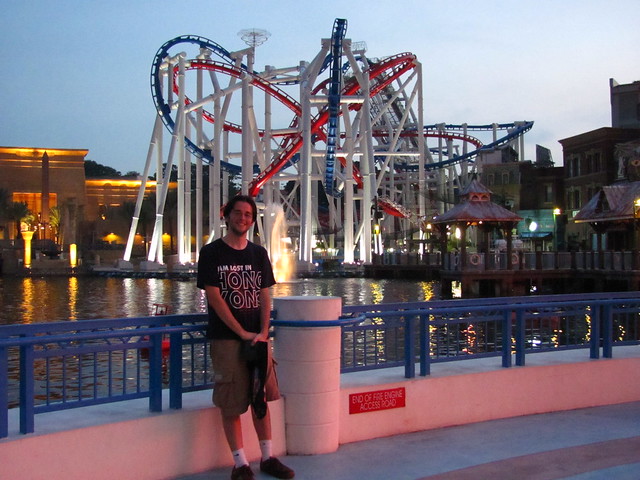 And that’s a wrap at Universal Studios Singapore…
And that’s a wrap at Universal Studios Singapore…

 But wait, just because the park is now closed doesn’t mean my adventure is over! After leaving the park I spent a bit of time to further explore Sentosa in search of what it claims is the southern-most point in continental Asia.
But wait, just because the park is now closed doesn’t mean my adventure is over! After leaving the park I spent a bit of time to further explore Sentosa in search of what it claims is the southern-most point in continental Asia.
The point is found along Palawan Beach.
Those lights on the horizon are all freighter ships.
Cross this rope suspension bridge to a small island.
And at a small overlook you can claim to have reached the furthest southern tip of Asia!
Technically I’m not sure if this is really the southern-most point of continental Asia. For one thing, it’s on an island off an island, and Singapore itself is sorta an island. Secondly, looking at a satellite map of Sentosa it sure looks like there’s a few other points that are further south than Palawan Beach. Regardless, at only a few miles north of the equator, it’s still a major personal achievement as the furthest south I’ve ever been in my life.
 This gecko wishes me farewell from Sentosa…
This gecko wishes me farewell from Sentosa…







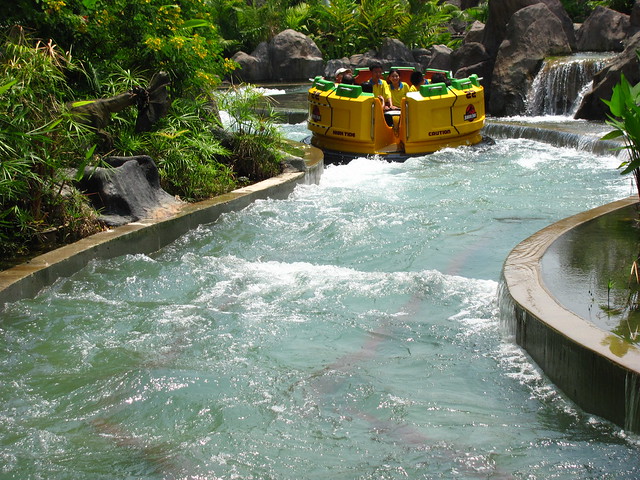







































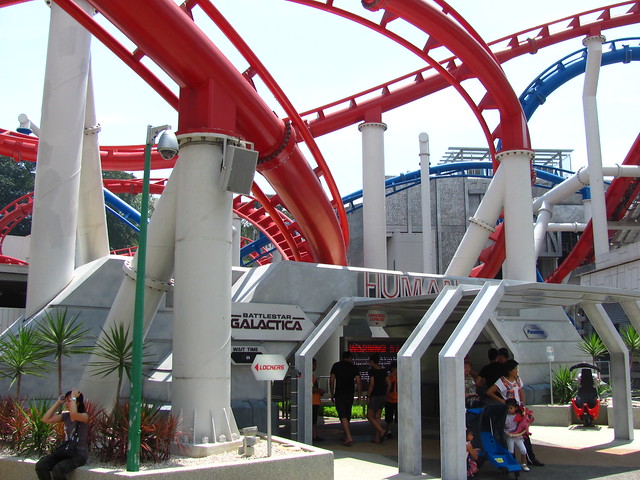





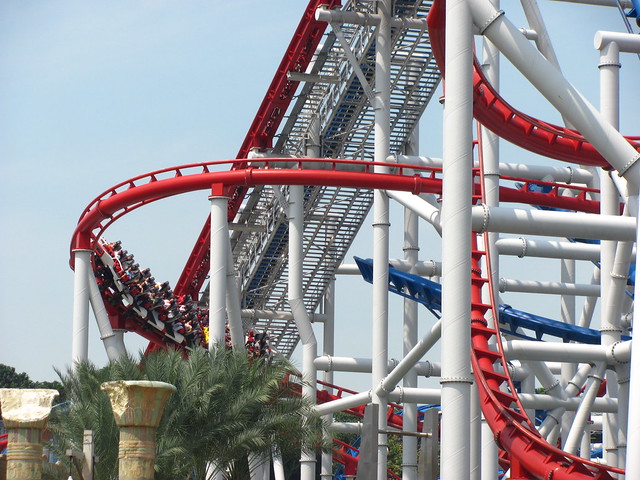













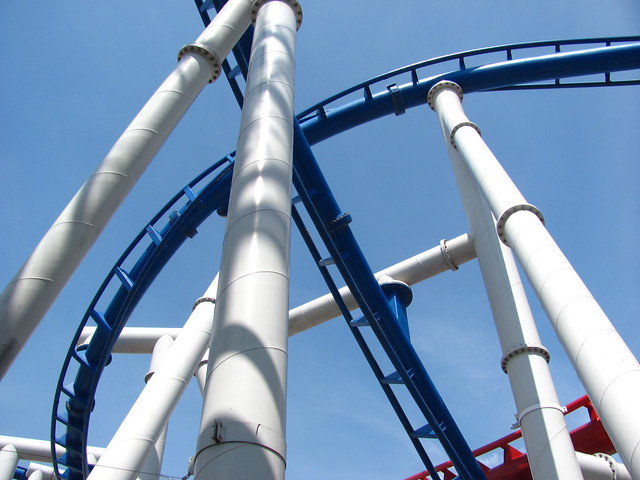













Comments